Themed collection Carbon Nanostructures in Biology and Medicine

Carbon nanostructures in biology and medicine
Guest editors Nazario Martín, Tatiana Da Ros and Jean-François Nierengarten introduce this Journal of Materials Chemistry B themed issue on carbon nanostructures in biology and medicine.

J. Mater. Chem. B, 2017,5, 6425-6427
https://doi.org/10.1039/C7TB90108A
Multivalency as an action principle in multimodal lectin recognition and glycosidase inhibition: a paradigm shift driven by carbon-based glyconanomaterials
Glyco(mimetic)-coated fullerenes and nanodiamonds are playing a decisive role in the investigation of the lectin–enzyme crosstalk behaviours elicited by (hetero)multivalency.
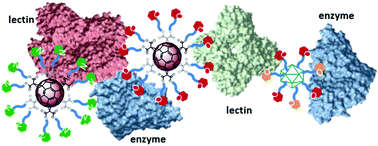
J. Mater. Chem. B, 2017,5, 6428-6436
https://doi.org/10.1039/C7TB00860K
Fullerenes in biology and medicine
Fullerenes and related carbon based derivatives have shown a growing relevance in biology and medicine, mainly due to the unique electronic and structural properties that make them excellent candidates for multiple functionalization.
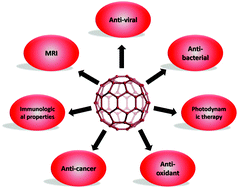
J. Mater. Chem. B, 2017,5, 6523-6535
https://doi.org/10.1039/C7TB00855D
Advances in biotechnological synthetic applications of carbon nanostructured systems
Immobilization of carbonic anhydrase on SWCNTs by application of the CNT binding peptide (CBP) strategy.
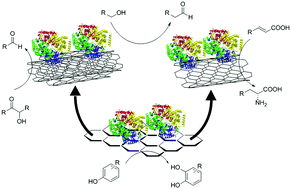
J. Mater. Chem. B, 2017,5, 6490-6510
https://doi.org/10.1039/C7TB00764G
Carbon nanostructures in biology and medicine
Carbon nanostructures have unique physical, chemical, and electrical properties, which have attracted great interest from scientists. Carbon dots, carbon nanotubes, graphene and other carbon nanomaterials are being successfully implemented in electrochemical sensing, biomedical and biological imaging.
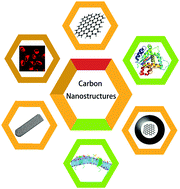
J. Mater. Chem. B, 2017,5, 6437-6450
https://doi.org/10.1039/C7TB00891K
Material chemistry of graphene oxide-based nanocomposites for theranostic nanomedicine
This review summarizes and discusses the development of the design, fabrication and biomedical applications of GO-based functional composites.
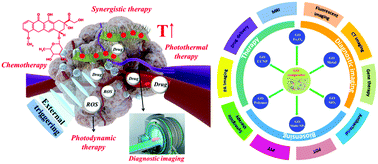
J. Mater. Chem. B, 2017,5, 6451-6470
https://doi.org/10.1039/C7TB00680B
Single-walled carbon nanotubes as optical probes for bio-sensing and imaging
A review on the applications of single-walled carbon nanotube photoluminescence in biomolecular sensing and biomedical imaging.
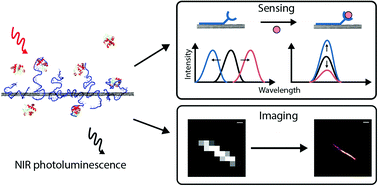
J. Mater. Chem. B, 2017,5, 6511-6522
https://doi.org/10.1039/C7TB00748E
Graphene quantum dots: multifunctional nanoplatforms for anticancer therapy
We review the recent advances in the application of GQDs as innovative nanoplatforms for anticancer therapy and bioimaging.
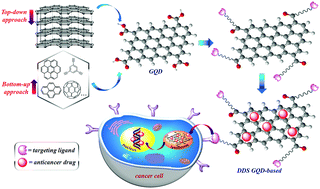
J. Mater. Chem. B, 2017,5, 6471-6489
https://doi.org/10.1039/C7TB00747G
Micro-Raman spectroscopy as an enabling tool for long-term intracellular studies of nanomaterials at nanomolar concentration levels
Imaging of individual SWCNTs inside neural stem cells has been demonstrated using confocal scanning Raman microscopy. Hyperspectral Raman imaging allowed detection of nanomaterials applied to the cell in ultra-low doses in long-term studies.
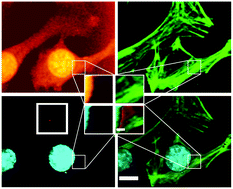
J. Mater. Chem. B, 2017,5, 6536-6545
https://doi.org/10.1039/C7TB00766C
Micelle vs. vesicle formation controlled by distal functionalization of C60–PEG conjugates
An amphiphilic C60–PEG conjugate was modified by the addition of cationic moieties in the hydrophobic C60 part to provide the related bis- and tris-adducts and their self-assembling structures were compared.
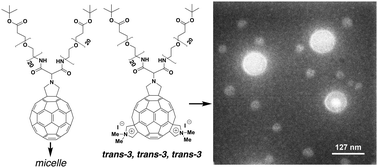
J. Mater. Chem. B, 2017,5, 6676-6680
https://doi.org/10.1039/C7TB00829E
Highly sensitive electrochemiluminescence detection of a prostate cancer biomarker
A novel electrochemiluminescence immunosensor based on carbon nanotubes for PSMA detection in very complex matrixes exceeds the state of-the-art.
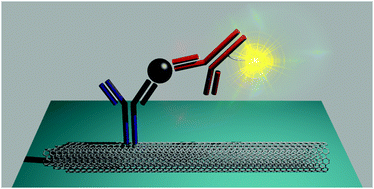
J. Mater. Chem. B, 2017,5, 6681-6687
https://doi.org/10.1039/C7TB01557G
Carbon nanodot impregnated fluorescent nanofibers for in vivo monitoring and accelerating full-thickness wound healing
Development of an intrinsically fluorescent nanofibrous scaffold of polycaprolactone–gelatin for skin tissue regeneration and noninvasive monitoring of scaffold activity in vivo.
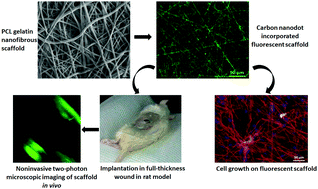
J. Mater. Chem. B, 2017,5, 6645-6656
https://doi.org/10.1039/C7TB00684E
Immune-camouflaged graphene oxide nanosheets for negative regulation of phagocytosis by macrophages
Immune-camouflaged GO nanosheets with CD47-like SIRPα binding molecules can reduce the phagocytosis by macrophages, enhancing tumor delivery.
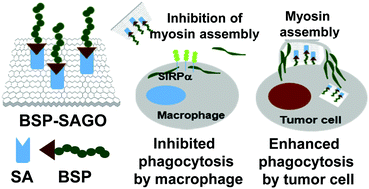
J. Mater. Chem. B, 2017,5, 6666-6675
https://doi.org/10.1039/C7TB00648A
Polymer cloaking modulates the carbon nanotube protein corona and delivery into cancer cells
Polycarbodiimide cloaking of photoluminescent single-walled carbon nanotubes modulates their surface chemistry, protein corona, and uptake in cancer cells.
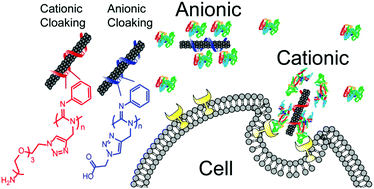
J. Mater. Chem. B, 2017,5, 6637-6644
https://doi.org/10.1039/C7TB00695K
Length-dependent intracellular bundling of single-walled carbon nanotubes influences retention
Single-walled carbon nanotubes undergo length-dependent intracellular bundling in macrophages that affects retention.
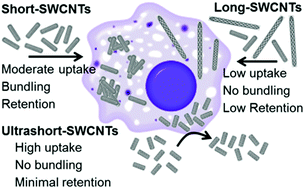
J. Mater. Chem. B, 2017,5, 6657-6665
https://doi.org/10.1039/C7TB00735C
Antiviral activity of self-assembled glycodendro[60]fullerene monoadducts
Supramolecular assemblies of amphiphilic glycodendro[60]fullerenes have been tested in an artificial Ebola virus infection assay.
![Graphical abstract: Antiviral activity of self-assembled glycodendro[60]fullerene monoadducts](/en/Image/Get?imageInfo.ImageType=GA&imageInfo.ImageIdentifier.ManuscriptID=C7TB01379E&imageInfo.ImageIdentifier.Year=2017)
J. Mater. Chem. B, 2017,5, 6566-6571
https://doi.org/10.1039/C7TB01379E
Onion derived carbon nanodots for live cell imaging and accelerated skin wound healing
Nitrogen, sulfur, and phosphorous co-doped water-soluble carbon nanodots are synthesized from culinary waste onion peel powder (OPP) by a short microwave treatment.
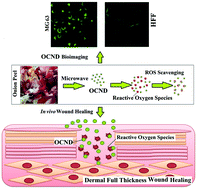
J. Mater. Chem. B, 2017,5, 6579-6592
https://doi.org/10.1039/C7TB00869D
Functionalization of bone implants with nanodiamond particles and angiopoietin-1 to improve vascularization and bone regeneration
Biodegradable β-TCP implant materials functionalized with diamond nanoparticles are generated and characterized.

J. Mater. Chem. B, 2017,5, 6629-6636
https://doi.org/10.1039/C7TB00723J
Hollow carbon nanospheres for targeted delivery of chemotherapeutics in breast cancer therapy
Functional hollow carbon nanospheres were prepared and antibody modified, which improved the targeted delivery of anti-tumor drug.

J. Mater. Chem. B, 2017,5, 6601-6607
https://doi.org/10.1039/C7TB01105A
Construction of giant glycosidase inhibitors from iminosugar-substituted fullerene macromonomers
A dramatic enhancement in the glycosidase multivalent inhibitory effect was observed while going from a dodecavalent iminosugar ball to the corresponding giant molecule with 120 peripheral subunits.
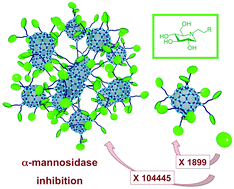
J. Mater. Chem. B, 2017,5, 6546-6556
https://doi.org/10.1039/C7TB01052D
Designing polymeric adhesives for antimicrobial materials: poly(ethylene imine) polymer, graphene, graphene oxide and molybdenum trioxide – a biomimetic approach
The synthesis of biocompatible polymers for coating applications has gained significant attention in recent years due to the increasing spread of infectious diseases via contaminated surfaces.
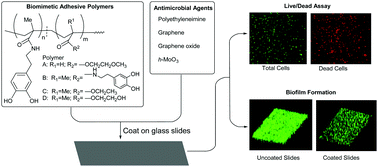
J. Mater. Chem. B, 2017,5, 6616-6628
https://doi.org/10.1039/C7TB00722A
C60@lysozyme: a new photosensitizing agent for photodynamic therapy
C60@lysozyme showed significant visible light-induced singlet oxygen generation in a physiological environment, indicating the potential of this hybrid as an agent for photodynamic therapy.
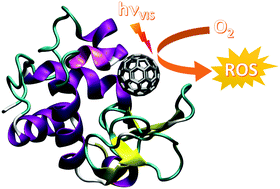
J. Mater. Chem. B, 2017,5, 6608-6615
https://doi.org/10.1039/C7TB00800G
On demand electrochemical release of drugs from porous reduced graphene oxide modified flexible electrodes
Despite the advantages of an electrochemical control of drug release, only a handful of electrochemical-based release systems have been developed so far.
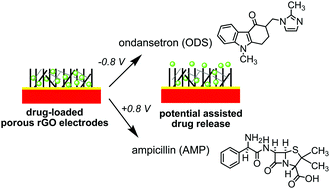
J. Mater. Chem. B, 2017,5, 6557-6565
https://doi.org/10.1039/C7TB00687J
Facile and scalable preparation of highly luminescent N,S co-doped graphene quantum dots and their application for parallel detection of multiple metal ions
New and bright N,S co-doped GQDs are synthesized and serve as fluorescence probes for parallel and selective detection of Fe3+, Cu2+ and Ag+ ions in biological and environmental samples.
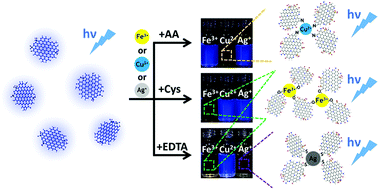
J. Mater. Chem. B, 2017,5, 6593-6600
https://doi.org/10.1039/C7TB00506G
Peroxidase activity of the coronene bisimide supramolecular architecture and its applications in colorimetric sensing of H2O2 and glucose
Distinct peroxidase-like catalytic activity of small organic probe self-assembled nanofibers is reported for the first time.
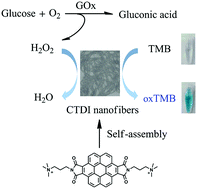
J. Mater. Chem. B, 2017,5, 6572-6578
https://doi.org/10.1039/C7TB00212B